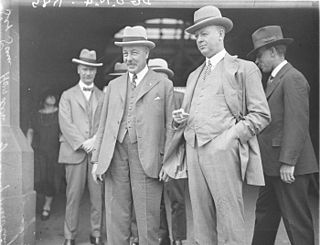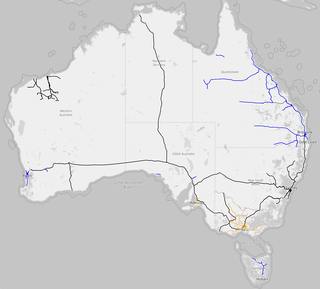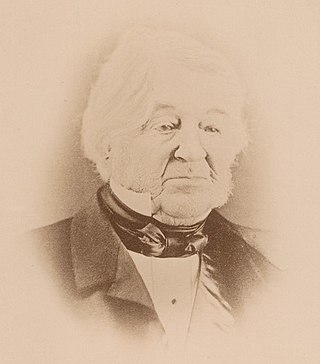
The Bank of New South Wales (BNSW), also known as The Wales, was the first bank in Australia. It was established in 1817 in Sydney. During the 19th century, the bank opened branches throughout Australia and New Zealand, expanding into Oceania in the 20th century. Throughout it history it merged with and purchased many other financial institutions. In 1981 it merged with the Commercial Bank of Australia and was renamed Westpac on 4 May 1982.

George Fife Angas was an English businessman and banker who, while residing in England, played a significant part in the formation and establishment of the Province of South Australia. He established the South Australian Company and was its founding chairman of the board of directors.
The Australian Scout Jamboree is a national jamboree overseen by Scouts Australia. They have been held regularly since 1934, except for 1942 and 1945 due to World War II, and in 2022 due to the COVID-19 pandemic. Jamborees are generally held early in January and typically runs for ten nights.

Sir Samuel Hordern was an Australian businessman, animal breeder and philanthropist. Born into the prominent Sydney trading family, Hordern directed the family company of Anthony Hordern & Sons from 1909 to 1926.

Rail gauges in Australia display significant variations, which has presented an extremely difficult problem for rail transport on the Australian continent since the 19th century. As of 2022, there are 11,914 kilometres (7,403 mi) of narrow-gauge railways, 18,007 kilometres (11,189 mi) of standard gauge railways and 2,685 kilometres (1,668 mi) of broad gauge railways. In the 19th century, each of the colonies of Australia adopted their own gauges.

Joseph Coles Kirby was an English flour miller who migrated to Sydney, Australia in 1854. In 1864, Kirby was ordained in the Congregational Churches and then ministered to rural and city congregations in Queensland and South Australia and supported or led many causes for social reform such as the temperance movement, women's suffrage and "social purity", raising the age of consent to 16 in Australia.

The Bank of Australasia was an Australian bank in operation from 1835 to 1951.

Reginald John Burchell was an Australian politician. He was a member of the Australian House of Representatives for the seat of Fremantle from 1913 to 1922, initially for the Australian Labor Party and after the 1916 Labor split for the Nationalist Party.

Walter Langdon Parsons was an Australian politician.

The English, Scottish & Australian Bank Limited was an Australian bank founded in 1852 by royal charter in London and named English, Scottish and Australian Chartered Bank. Following a financial reconstruction in 1893 its business was renamed English, Scottish and Australian Bank Limited.

Osmond Gilles was a settler, pastoralist, mine owner and the Colony of South Australia’s first colonial treasurer.

Wakefield Street is a main thoroughfare intersecting the centre of the South Australian capital, Adelaide, from east to west at its midpoint. It crosses Victoria Square in the centre of the city, which has a grid street plan. It continues as Wakefield Road on its eastern side, through the eastern Adelaide Park Lands.

John Jackson Oakden, pastoralist, was an English explorer of South Australia, part of the European exploration of Australia, and a pioneer runholder of the Canterbury region of New Zealand.
The first Bank of South Australia was founded by the South Australian Company in the colony of South Australia in 1837 by British investors. It became defunct in 1892, when it was taken over by the Union Bank of Australia.
Hedley Allen Dunn was a South Australian architect, a member of the prominent Dunn family of Mount Barker. His work included the flour mill at Port Adelaide for his father and grandfather in 1886, and the Stock Exchange Building on McHenry Street, off Grenfell Street, Adelaide, in 1900.
Joseph Robertson was an Australian Congregationalist minister.

May Gertrude Shepherd , was an Australian aviator and the first woman in Australia to hold first class pilot's 'A', 'B' and 'C' licences concurrently, in addition to a 'D' electrical ground engineers' certificate. She was also the first and the only woman in Australia, at the time, known to hold a 'X' certificate in oxy-welding and metallurgy.
The Building Workers' Industrial Union of Australia was an Australian trade union covering workers in the construction industry.
Edward Angas Johnson, known as Angas or E. Angas Johnson, was City Health Officer of Adelaide, South Australia. His name has very frequently been misspelled as "Angus" Johnson.
The London Chartered Bank of Australia was an English-run Australian bank which operated from 1852 to 1921.














